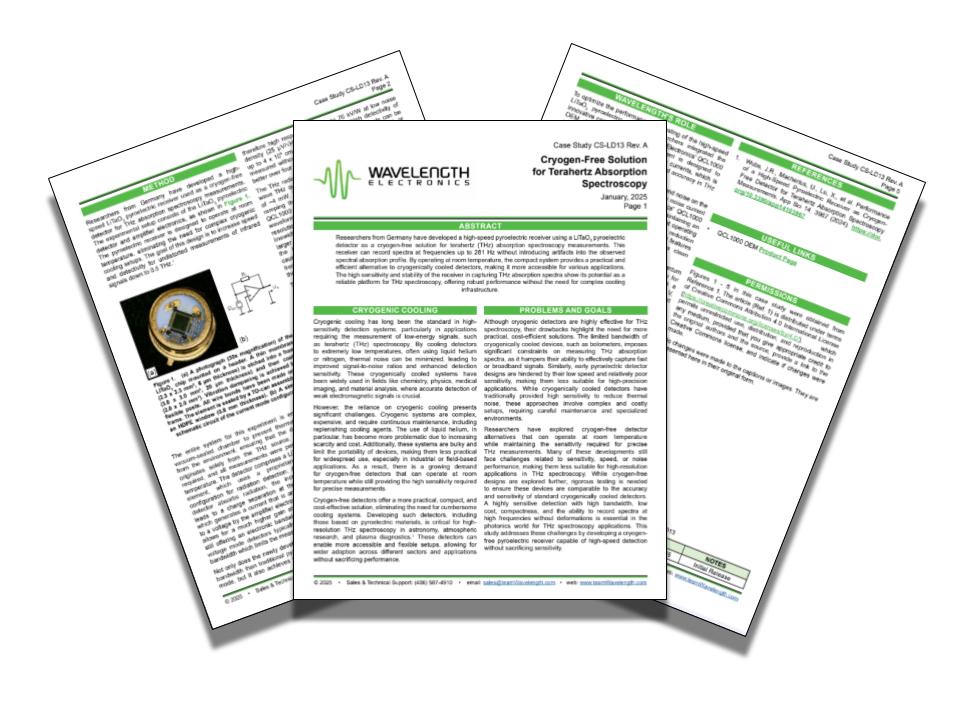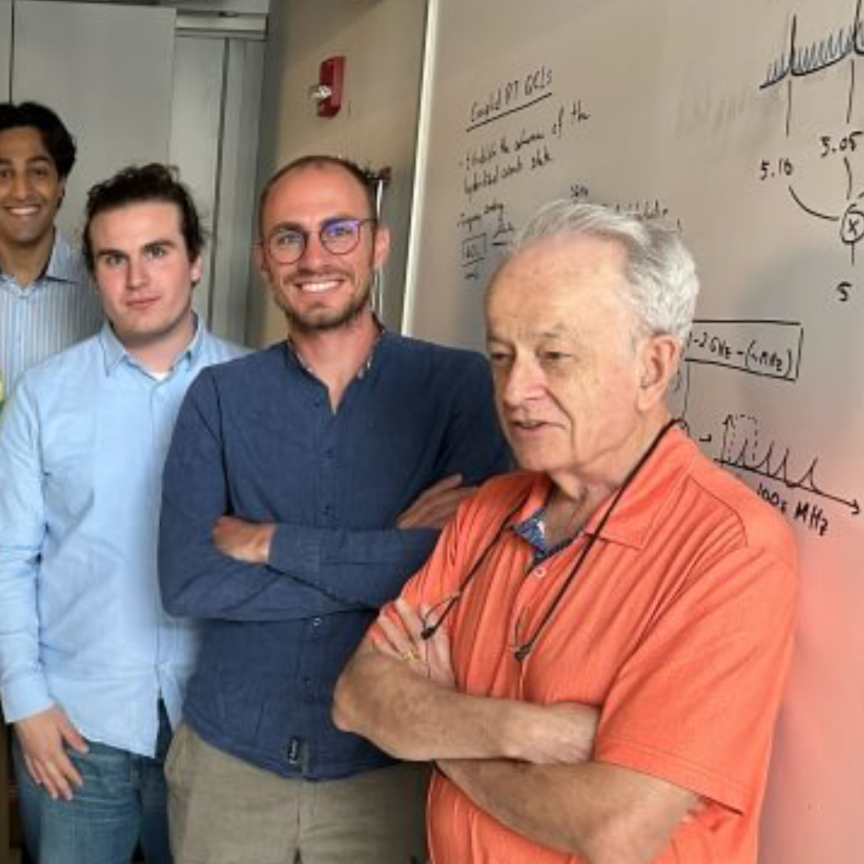Terahertz (THz) spectroscopy uses electromagnetic radiation in the THz frequency band (0.1 to 10THz)in order to probe materials, to find information about their properties and structure, including molecular interactions and dynamics.
The technique is used in a wide range of applications, such as material characterisation, biomolecule recognition, security, medical imaging and diagnostics. It offers a number of benefits, for example, THz radiation is non-ionizing, making it safe for many applications. It can also penetrate through certain materials that are opaque to visible light, such as polymers, ceramics, and semiconductors, allowing for the study of their internal structure.
The technique is also highly sensitive to changes in material properties, allowing for the detection of subtle variations.
THz spectroscopy also has its own challenges. Many THz detectors and some sources require extremely low temperatures in order to minimise thermal noise and maximise sensitivity. This can introduce complexities such as the high cost and power consumption of cryogenic systems, the difficulties in maintaining stable temperatures, and the need for specialised materials that can withstand these extreme conditions. In addition, the physical bulk of cryogenic equipment can hinder the development of more compact and portable THz spectroscopy devices, which are becoming increasingly desirable.
Enter a team of researchers from Germany, which has addressed these limitations by developing a high-speed LiTaO₃ pyroelectric receiver that operates at room temperature. This system can record spectra at frequencies up to 281Hz without introducing artifacts into the observed spectral absorption profile.
Jeremiah Hashley, a technical writer with Wavelength Electronics explains: "The researchers wanted to develop a high-speed pyroelectric receiver to use for THz absorption spectroscopy. They needed a reliable system for this application to show its potential in fields like chemistry, physics, medical imaging, and material analysis. The novel portion of this design is a cryogen-free detector, enabling operation at room temperature and a compact system as an alternative to the cryogenically cooled detector. This makes the system more accessible for a variety of applications."
Meeting the precision requirements
Playing a key role in the success of this project was the Wavelength Electronics' QCL1000 OEM driver, which provided precise control over quantum cascade laser drive currents. Says Hashley: “This is essential for optimal sensitivity and accuracy in THz absorption spectroscopy. Because the driver maintains an output current RMS noise of less than 0.7µA, the system can accurately capture rapid spectral features in absorption spectroscopy while keeping a clean spectral absorption profile without introducing artifacts."
The driver's low noise floor was particularly beneficial for this application, as Hashley explains: "Because the QCLs' most important parameters are high stability and low noise, any wavelength jitter from driver noise or current instability from driver output can reduce the overall system sensitivity by orders of magnitude. Wavelength Electronics designed the QCL drivers with noise performance in mind from the beginning, so the QCL wavelength will remain stable, without jitter, and maintain a narrow linewidth."
The importance of narrow linewidth
This ability to maintain a narrow linewidth of approximately 6 MHz was highlighted as crucial for spectral resolution in the study, as this precision is not easily achieved and represents a significant technical accomplishment. Hashley explains: "Below 6MHz is usually considered a relatively narrow linewidth and can require active stabilisation. Two of the more common sources of linewidth broadening are temperature fluctuations and inconsistent and noisy drive currents. Reducing these noise sources is Wavelength Electronics' speciality."
He continues: "If the drive current is noisy, the laser frequency and linewidth can be affected, negatively impacting the experiment or project. By eliminating or decreasing the driver noise to a minuscule amount and maintaining active current stabilisation, the QCL linewidth and output can remain constant and stable for repeatable and reliable measurements."
Innovative approach to spectral measurements
Unlike conventional approaches that rely on bolometers requiring cryogenic cooling, the pyroelectric receiver can operate at room temperature while still providing high sensitivity and accuracy. The system's design enables high-resolution spectral measurements with minimal noise and artifact-free absorption profiles.
A key feature of the experimental setup was the continuous ramping of laser current using a sawtooth waveform, which enabled fast measurements with high spectral resolution. This capability was made possible by the QCL1000 OEM driver's features.
"The high modulation bandwidth of the QCL1000 OEM driver and fast rise-time maintain modulation waveform integrity so the researchers could shape the laser output profile exactly as the THz spectroscopy application required," says Hashley. "With input modulation frequency, the driver can modulate the current output in the sawtooth waveform needed for the laser tuning."
Looking at the QCL1000 OEM driver itself, Hashley explains: "Wavelength Electronics has a few options for QCL drivers: OEM modules as well as benchtop instruments with intuitive touchscreen control. They are available in different models with output currents from 500 mA up to 2 A with noise ranging from 0.4µA RMS to 1.3µA RMS. Not much has changed on these drivers as the patented design continues to enable better performance with the ultra-low noise current source."
Supporting the trend toward cryogen-free approaches
The company has positioned its products to support the growing trend toward cryogen-free approaches in the scientific community. "Although cryogen-free techniques would simplify and shrink designs, lasers and other electronic or optical components still need high temperature and current stability," Hashley explains. "Wavelength Electronics continues to design high-performance drivers and controllers in either compact, handheld sizes or benchtop instruments for ease-of-use operation."
Beyond THz spectroscopy, Wavelength Electronics' QCL drivers are being used in a variety of other fields. "A lot of our QCL drivers are used in other spectroscopy applications in the environmental field, specifically in gas sensing. Other applications include communications, biomedical, frequency combs, and some quantum studies," says Hashley.
Looking to the future
As THz technology continues to develop, Hashley identifies several promising directions: "As Wavelength Electronics looks towards the future of THz technology, a few applications stand out: security checks and detections, safety inspections for hazardous materials, and telecommunications in high-speed wireless areas. Other fields, like quality control in manufacturing, pharmaceuticals, product integrity, and reducing waste, continue to evolve with advancements in terahertz technology, enabling more precise, efficient, and non-destructive inspection methods."
The company is committed to advancing its technology to support these emerging applications. "We want to further our low-noise technology by continuing to provide manufacturers and researchers with the best high-performance drivers and temperature controllers for any application they need," says Hashley. "Watch for our new products to see how they can help lower your noise and ensure repeatable results."



